2006 云南考研英语一真题及答案
Section I
Directions:
Use of English
Read the following text. Choose the best word(s) for each numbered blank and mark
[A], [B], [C] or [D] on ANSWER SHEET 1. (10 points)
The homeless make up a growing percentage of America ’ s population. ___1___
homelessness has reached such proportions that local governments can’t possibly
___2___. To help homeless people ___3___ independence, the federal government must
support job training programs, ___4___ the minimum wage, and fund more low-cost
housing.
___5___ everyone agrees on the number of Americans who are homeless. Estimates
___6___ anywhere from 600,000 to 3 million. ___7___ the figure may vary, analysts
do agree on another matter: that the number of the homeless is ___8___. One of the
federal government’s studies ___9___ that the number of the homeless will reach
nearly 19 million by the end of this decade.
Finding ways to ___10___ this growing homeless population has become increasingly
difficult. ___11___ when homeless individuals manage to find a ___12___ that will
give them three meals a day and a place to sleep at night, a good number still spend
the bulk of each day ___13___ the street. Part of the problem is that many homeless
adults are addicted to alcohol or drugs. And a significant number of the homeless
have serious mental disorders. Many others, ___14___ not addicted or mentally ill,
simply lack the everyday ___15___ skills needed to turn their lives ___16___. Boston
Globe reporter Chris Reidy notes that the situation will improve only when there
are ___17___ programs that address the many needs of the homeless. ___18___ Edward
Zlotkowski, director of community service at Bentley College in Massachusetts,
___19___ it, “There has to be ___20___ of programs. What’s needed is a package
deal.”
1.
[A] Indeed
[B] Likewise
[C] Therefore
[D] Furthermore
2.
[A] stand
�
[B] cope
[C] approve
[D] retain
3.
[A] in
[B] for
[C] with
[D] toward
4.
[A] raise
[B] add
[C] take
[D] keep
5.
[A] generally
[B] almost
[C] hardly
[D] not
6.
[A] cover
[B] change
[C] range
[D] differ
7.
[A] Now that
[B] Although
[C] Provided
�
[D] Except that
8.
[A] inflating
[B] expanding
[C] increasing
[D] extending
9.
[A] predicts
[B] displays
[C] proves
[D] discovers
10.
[A] assist
[B] track
[C] sustain
[D] dismiss
11.
[A] Hence
[B] But
[C] Even
[D] Only
12.
[A] lodging
[B] shelter
[C] dwelling
[D] house
13.
[A] searching
�
[B] strolling
[C] crowding
[D] wandering
14.
[A] when
[B] once
[C] while
[D] whereas
15.
[A] life
[B] existence
[C] survival
[D] maintenance
16.
[A] around
[B] over
[C] on
[D] up
17.
[A] complex
[B] comprehensive
[C] complementary
[D] compensating
18.
[A] So
[B] Since
[C] As
�
[D] Thus
19.
[A] puts
[B] interprets
[C] assumes
[D] makes
20.
[A] supervision
[B] manipulation
[C] regulation
[D] coordination
Reading Comprehension
Section II
Part A
Directions:
Read the following four texts. Answer the questions below each text by choosing [A],
[B], [C], or [D]. Mark your answers on ANSWER SHEET 1. (40 points)
Text 1
In spite of “endless talk of difference,” American society is an amazing machine
for homogenizing people. There is “ the democratizing uniformity of dress and
discourse, and the casualness and absence of deference” characteristic of popular
culture. People are absorbed into “a culture of consumption” launched by the
19th-century department stores that offered “vast arrays of goods in an elegant
atmosphere. Instead of intimate shops catering to a knowledgeable elite,” these
were stores “anyone could enter, regardless of class or background. This turned
shopping into a public and democratic act.” The mass media, advertising and sports
are other forces for homogenization.
Immigrants are quickly fitting into this common culture, which may not be altogether
elevating but is hardly poisonous. Writing for the National Immigration Forum,
Gregory Rodriguez reports that today’s immigration is neither at unprecedented
levels nor resistant to assimilation. In 1998 immigrants were 9.8 percent of
population; in 1900, 13.6 percent. In the 10 years prior to 1990, 3.1 immigrants
arrived for every 1,000 residents; in the 10 years prior to 1890, 9.2 for every 1,000.
Now, consider three indices of assimilation -- language, home ownership and
intermarriage.
�
The 1990 Census revealed that “a majority of immigrants from each of the fifteen
most common countries of origin spoke English ‘well’ or ‘very well’ after ten
years of residence.” The children of immigrants tend to be bilingual and proficient
in English. “By the third generation, the original language is lost in the majority
of immigrant families.” Hence the description of America as a “graveyard” for
languages. By 1996 foreign-born immigrants who had arrived before 1970 had a home
ownership rate of 75.6 percent, higher than the 69.8 percent rate among native-born
Americans.
Foreign-born Asians and Hispanics “have higher rates of intermarriage than do
U.S.-born whites and blacks.” By the third generation, one third of Hispanic women
are married to non-Hispanics, and 41 percent of Asian-American women are married
to non-Asians.
Rodriguez notes that children in remote villages around the world are fans of
superstars like Arnold Schwarzenegger and Garth Brooks, yet “some Americans fear
that immigrants living within the United States remain somehow immune to the nation’
s assimilati ve power.”
Are there divisive issues and pockets of seething anger in America? Indeed. It is
big enough to have a bit of everything. But particularly when viewed against America’
s turbulent past, today’s social indices hardly suggest a dark and deteriorating
social environment.
The word “ homogenizing ” (Line 2, Paragraph 1) most probably means
21.
________________________.
[A] identifying
[B] associating
[C] assimilating
[D] monopolizing
According to the author, the department stores of the 19th century
22.
________________________.
[A] played a role in the spread of popular culture
[B] became intimate shops for common consumers
[C] satisfied the needs of a knowledgeable elite
�
[D] owed its emergence to the culture of consumption
23.
The text suggests that immigrants now in the U.S. ________________________.
[A] are resistant to homogenization
[B] exert a great influence on American culture
[C] are hardly a threat to the common culture
[D] constitute the majority of the population
24.
Why are Arnold Schwarzenegger and Garth Brooks mentioned in Paragraph 5?
[A] To prove their popularity around the world.
[B] To reveal the public’s fear of immigrants.
[C] To give examples of successful immigrants.
[D] To show the powerful influence of American culture.
In the author’s opinion, the absorption of immigrants into American society
25.
is ________________________.
[A] rewarding
[B] successful
[C] fruitless
[D] harmful
Text 2
Stratford-on-Avon, as we all know, has only one industry -- William Shakespeare --
but there are two distinctly separate and increasingly hostile branches. There is
the Royal Shakespeare Company (RSC), which presents superb productions of the plays
at the Shakespeare Memorial Theatre on the Avon. And there are the townsfolk who
largely live off the tourists who come, not to see the plays, but to look at Anne
Hathaway’s Cottage, Shakespeare’s birthplace and the other sights.
The worthy residents of Stratford doubt that the theatre adds a penny to their revenue.
They frankly dislike the RSC’s actors, them with their long hair and beards and
sandals and noisiness. It ’ s all deliciously ironic when you consider that
�
Shakespeare, who earns their living, was himself an actor (with a beard) and did
his share of noise-making.
The tourist streams are not entirely separate. The sightseers who come by bus --
and often take in Warwick Castle and Blenheim Palace on the side -- don’t usually
see the plays, and some of them are even surprised to find a theatre in Stratford.
However, the playgoers do manage a little sight-seeing along with their playgoing.
It is the playgoers, the RSC contends, who bring in much of the town’s revenue because
they spend the night (some of them four or five nights) pouring cash into the hotels
and restaurants. The sightseers can take in everything and get out of town by
nightfall.
The townsfolk don’t see it this way and local council does not contribute directly
to the subsidy of the Royal Shakespeare Company. Stratford cries poor traditionally.
Nevertheless every hotel in town seems to be adding a new wing or cocktail lounge.
Hilton is building its own hotel there, which you may be sure will be decorated with
Hamlet Hamburger Bars, the Lear Lounge, the Banquo Banqueting Room, and so forth,
and will be very expensive.
Anyway, the townsfolk can’t understand why the Royal Shakespeare Company needs a
subsidy. (The theatre has broken attendance records for three years in a row. Last
year its 1,431 seats were 94 percent occupied all year long and this year they’
ll do better.) The reason, of course, is that costs have rocketed and ticket prices
have stayed low.
It would be a shame to raise prices too much because it would drive away the young
people who are Stratford’s most attractive clientele. They come entirely for the
plays, not the sights. They all seem to look alike (though they come from all over)
-- lean, pointed, dedicated faces, wearing jeans and sandals, eating their buns and
bedding down for the night on the flagstones outside the theatre to buy the 20 seats
and 80 standing-room tickets held for the sleepers and sold to them when the box
office opens at 10:30 a.m.
26.
From the first two paragraphs, we learn that ________________________.
[A] the townsfolk deny the RSC’s contribution to the town’s revenue
[B] the actors of the RSC imitate Shakespeare on and off stage
[C] the two branches of the RSC are not on good terms
[D] the townsfolk earn little from tourism
27.
It can be inferred from Paragraph 3 that ________________________.
�
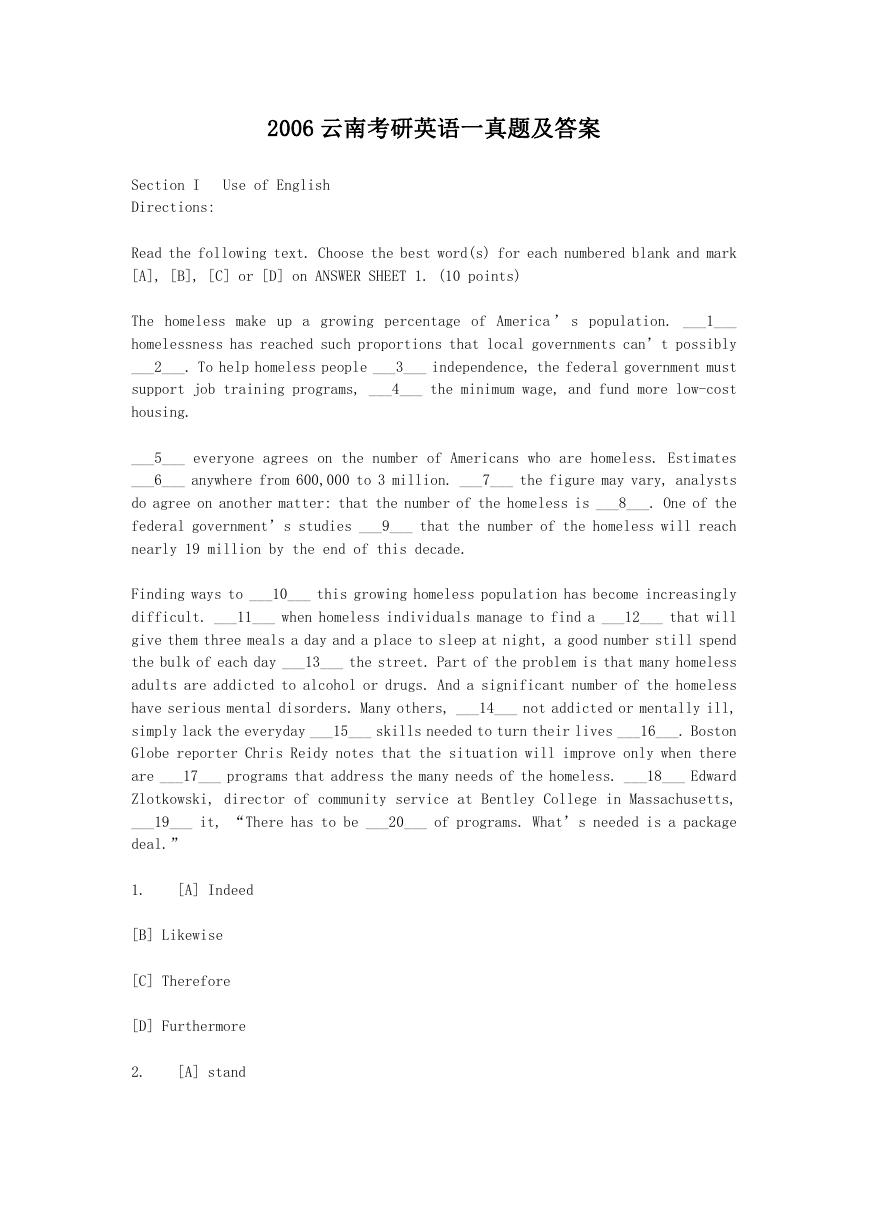



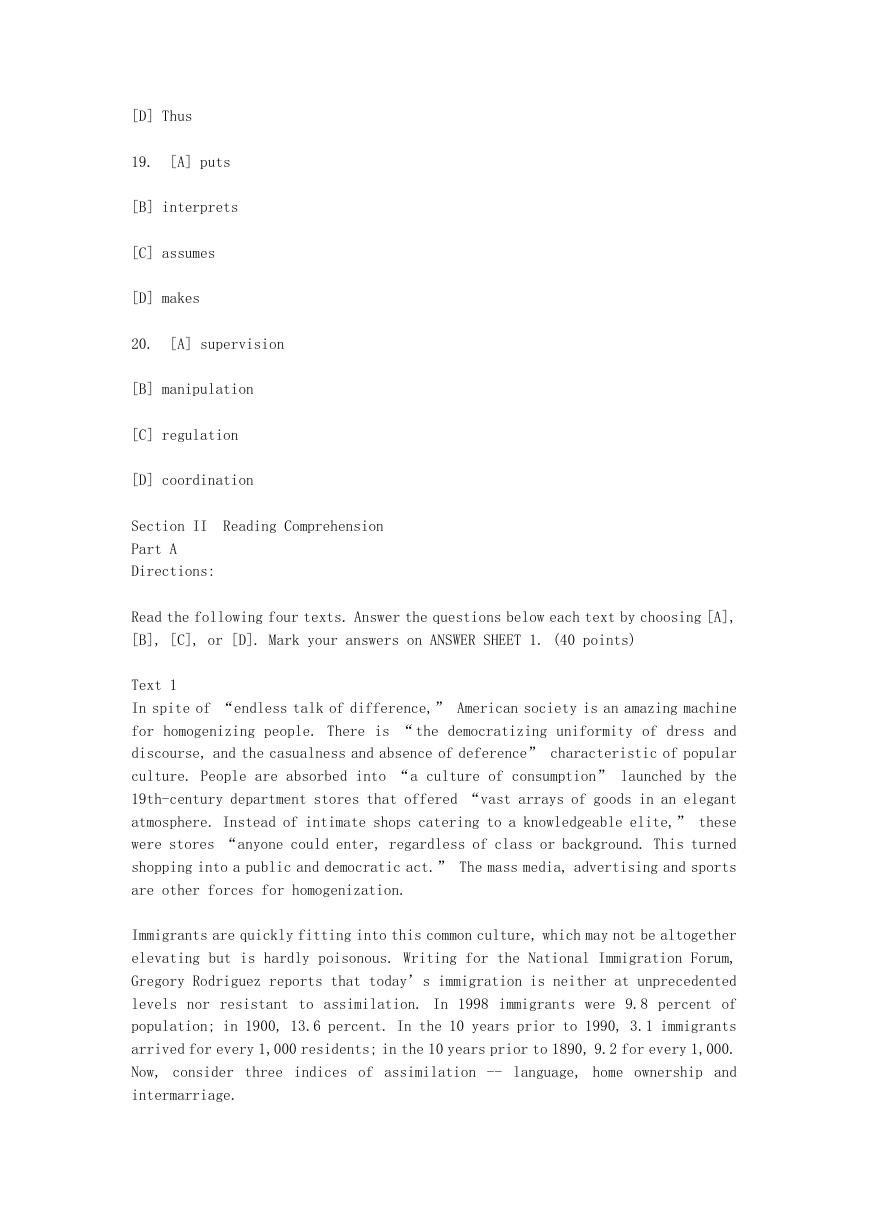
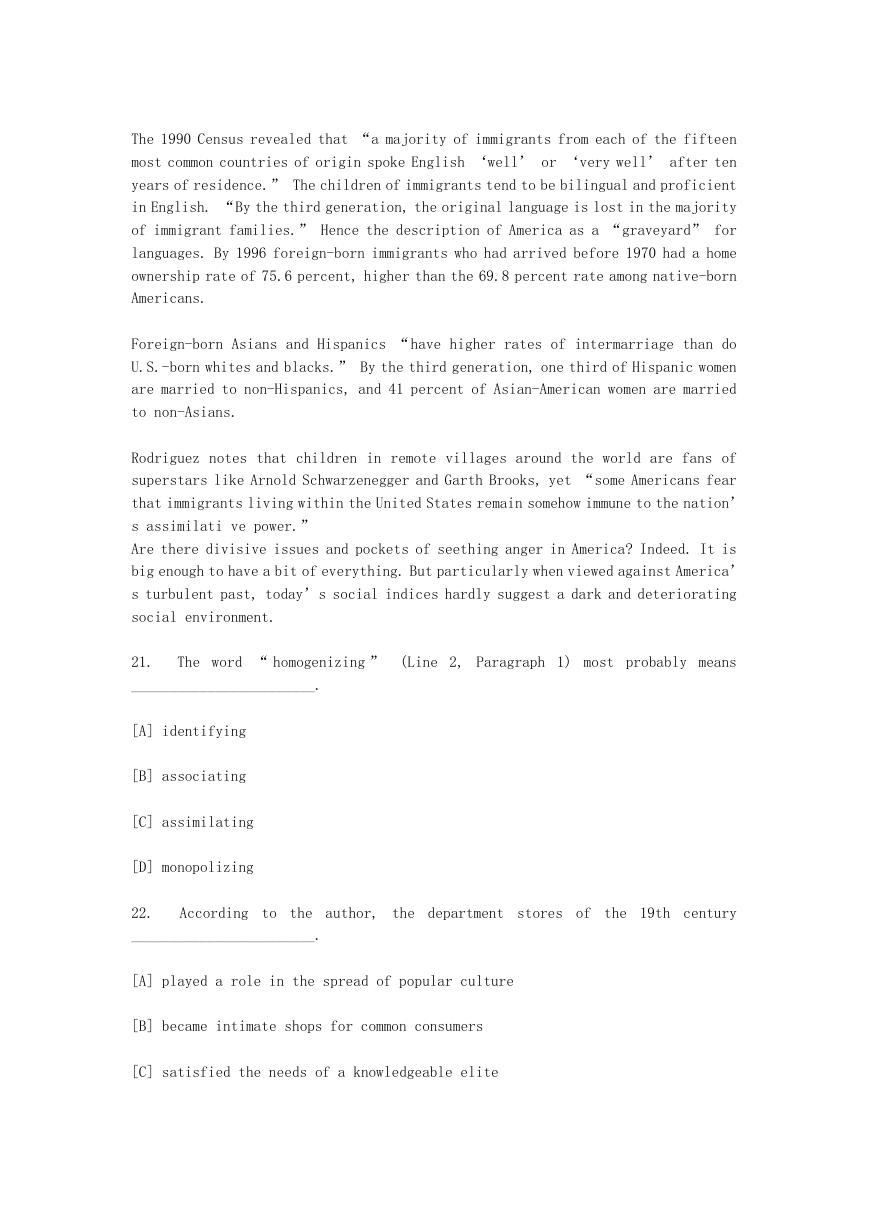
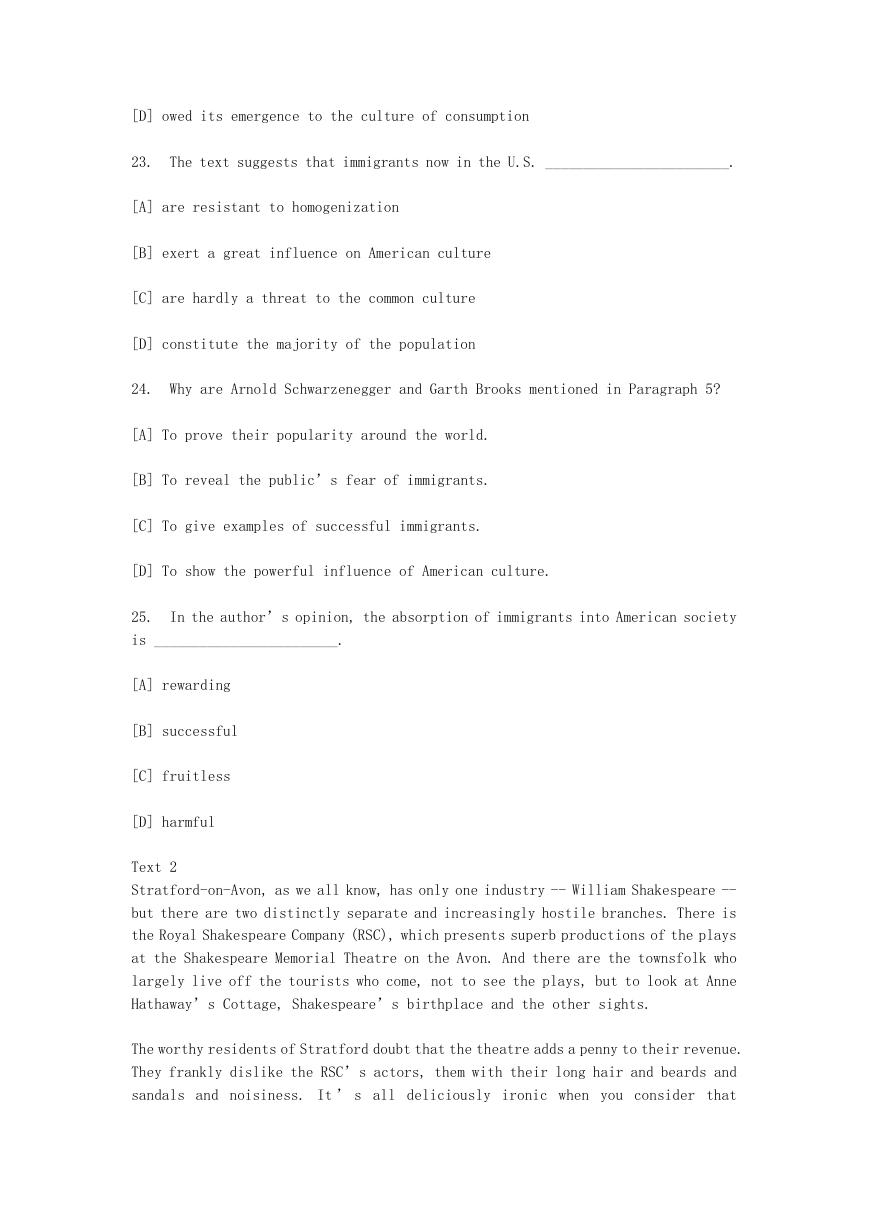
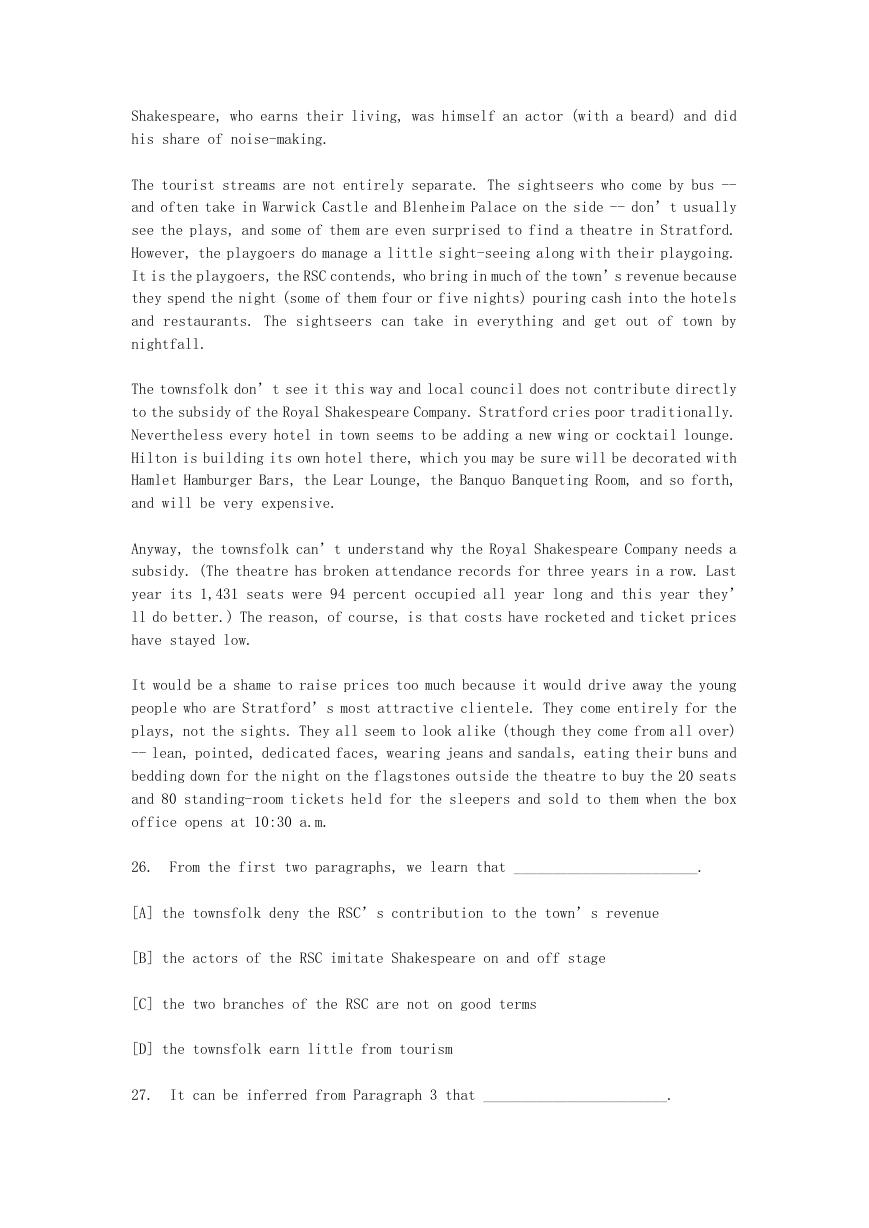








 2023年江西萍乡中考道德与法治真题及答案.doc
2023年江西萍乡中考道德与法治真题及答案.doc 2012年重庆南川中考生物真题及答案.doc
2012年重庆南川中考生物真题及答案.doc 2013年江西师范大学地理学综合及文艺理论基础考研真题.doc
2013年江西师范大学地理学综合及文艺理论基础考研真题.doc 2020年四川甘孜小升初语文真题及答案I卷.doc
2020年四川甘孜小升初语文真题及答案I卷.doc 2020年注册岩土工程师专业基础考试真题及答案.doc
2020年注册岩土工程师专业基础考试真题及答案.doc 2023-2024学年福建省厦门市九年级上学期数学月考试题及答案.doc
2023-2024学年福建省厦门市九年级上学期数学月考试题及答案.doc 2021-2022学年辽宁省沈阳市大东区九年级上学期语文期末试题及答案.doc
2021-2022学年辽宁省沈阳市大东区九年级上学期语文期末试题及答案.doc 2022-2023学年北京东城区初三第一学期物理期末试卷及答案.doc
2022-2023学年北京东城区初三第一学期物理期末试卷及答案.doc 2018上半年江西教师资格初中地理学科知识与教学能力真题及答案.doc
2018上半年江西教师资格初中地理学科知识与教学能力真题及答案.doc 2012年河北国家公务员申论考试真题及答案-省级.doc
2012年河北国家公务员申论考试真题及答案-省级.doc 2020-2021学年江苏省扬州市江都区邵樊片九年级上学期数学第一次质量检测试题及答案.doc
2020-2021学年江苏省扬州市江都区邵樊片九年级上学期数学第一次质量检测试题及答案.doc 2022下半年黑龙江教师资格证中学综合素质真题及答案.doc
2022下半年黑龙江教师资格证中学综合素质真题及答案.doc